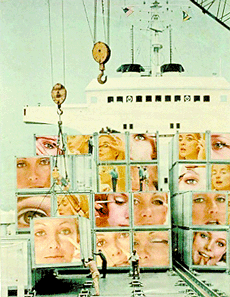Martha Rosler montage captures nearly a half-century of American quirkiness
Certain images from “Bringing the War Home: House Beautiful/In Vietnam,” Martha Rosler’s photo-collage series from the late 1960s, have become so embedded in our art-consciousness as to be nearly invisible.
Rosler’s powerful new exhibition, “Photomontages 1965-2004” at Gorney Bravin + Lee, cuts through the intervening decades of self-conscious conceptual knock-offs and goes a long way towards restoring the profound “aha!” moment to this incisive and original artist and her work.
The exhibition presents more or less familiar works in the context of 14 new collages. With small concessions to recent developments in digital imaging, Rosler’s formal methods of construction have remained constant. Precise framing combined with inexact cutting give the work an immediacy that is blessedly de-aestheticized, simultaneously calling attention to a picture’s seams and its resistance to the cosmetic allures of Photoshop and digital manipulation. So too have Rosler’s subjects remained consistent. The art world’s “big” topics of the past 30 years show up here—war, sexism, consumerism and how art and the media function within a capitalist system—with a directness and wonderfully devilish wit.
Pictures from the late 1960s such as “Vacation Getaway” and “House Beautiful, Giacometti” rely on two-punch interventions that collage Vietnam War images into the grand windows of clean, white, Modernist interiors. In what could be read as a contemporary indictment of the relevancy of painting, battle photographs are super-sized into history paintings by virtue of their placement inside panoramic windows. The relationship of decoration to oblivious bourgeois “connoisseurship” is embodied by an alienated bronze figure by Giacometti, artfully arranged before an all too-real scene of conflict.
“Saddam’s Palace (Febreeze),” a 2004 montage, literally inverts the set-up of earlier works. Here the stuttering images of a delighted housewife are captured, stop motion, as she “freshens up” the bombed-out shell of Saddam Hussein’s palace. If at times the relentless female stereotype—domestic worker or sexual plaything that has concerned Rosler ever since 1965—feels a bit fusty, take a closer look at “Cellular” (2004). The compliant, well-scrubbed faces of pretty young women holding cell phones bob cheerfully before an Iraqi sky, ratcheted with the plumes of a rocket attack.
This round of the good fight goes to Martha Rosler.


































